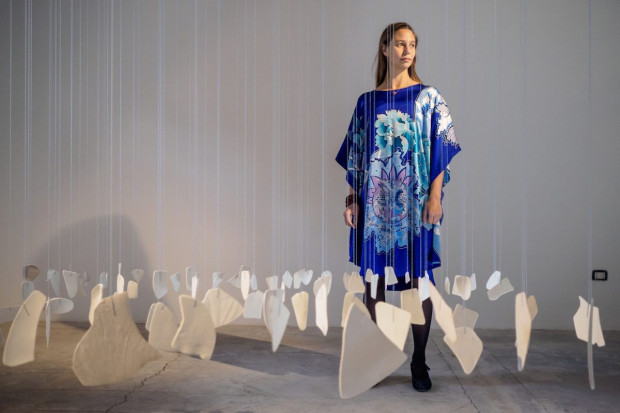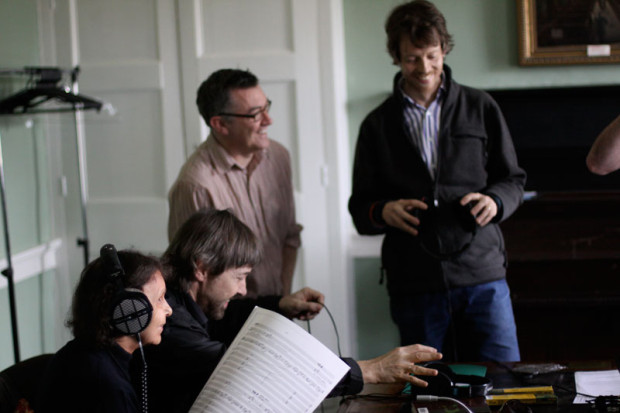
Photo: Dónal Sarsfield
Live Reviews: Sligo New Music
This year, with the the Model Arts and Niland Gallery’s reduction to building site, Sligo New Music shrank to a one-day event, visiting two new venues about Sligo Town: the Presbyterian Church and St Anne’s Community Centre. But, as this SNM revealed, size really doesn’t matter. Eccentric but intelligent curation, a consistently high standard of instrumental performance and a buoyant festival energy all reaffirm SNM’s identity.
The Dutch composer, Jacob Ter Velhuis, better known as the ‘rebranded’ Jacob TV, took centre stage, with numerous pieces for performer and ‘boombox’: dense, rhymical collages made from cut up recordings of American media and pop culture, from Jerry Springer shows to street preachers. They are slickly produced, virtuosic pieces showing the ridiculous through a kaleidoscopic lens. The occasional addition of instrumental tracks in the boombox part gives the parody a Karaoke flavour. (A PA was used rather than an actual boombox, which may have been less ‘authentic’, but it certainly made everything louder.)
For all the fun and games, there’s something irritatingly provocative and reactionary about Jacob TV. A glance at his website will reveal that he stands out ‘to the washed-up avant garde’ making him ‘a controversial figure’, ‘spurning dissonance’ as a ‘devalued means of expression’. An inspired programming move followed TV’s Heartbreakers with Stockhausen’s 1961 Klavierstück IX, a piece that still sounds fresh nearly half a century later. In that jarring light, TV’s attack on a perceived avant garde seemed adolescent.
In fact, such juxtapositions were to characterise the festival. Particularly memorable were Maria McGarry’s performances of two piano sonatas (Nos 2 and 4) by the Romanian-French composer Horatiu Radulescu, who sadly died the following week. These are expansive pieces, skirting extremes of dynamic and range. They’re erratic yet controlled, cosmopolitan yet unified. McGarry handled both pieces with patient timing and pedal-work, carefully constructing Radulescu’s resonant worlds.
Sligo-based Cathal Roche performed his own work, The Message, for saxophone and tape, a single text recited by twelve speakers from around the globe. The English text was inconsequentially nonsensical, but the changing accents applied to its repetitions provided the thrust for Roche’s protean improvisations. Roche also performed in Ian Wilson’s Boom!, which featured an excerpt from Irish radio, with occasional looping of individual words and layering of material and a pre-recorded saxophone part. Over this, Roche improvised a busy, saturated sheet of sound for nearly a quarter of an hour. I’m no stranger to prolonged, intense, noise works, but I struggled with this. The tape production was crude, and I was disappointed when, well into the piece, Roche turned to clichéd tongue-clackings in an attempt to make interesting a piece that wasn’t about maintaining interest. It was, perhaps, meant as a comment on the intellectual noise generated by economics babble on the airwaves á la Jacob TV; but in the context of TV’s works it simply demonstrated the relative excellence of Irish broadcasting compared to US media! Wilson seems to have been expanding the gamut over the last year or so, increasingly involving improvisation and other media in his work. Happily, I made it to his Tundra, to me a much more polished multi-media dance work, at the Fringe Festival in Dublin a few weeks earlier.
Siobhán Cleary’s festival-commissioned Conachlann, for piano and saxophone quartet, powered ahead, slowly but forcefully, like a dirge or chaconne. Low drones and miniature melodic steps in the saxophone choir met with athletic piano chords and a hurried soprano saxophone solo. It’s a reconciliation of opposites reminiscent of Radulescu, who subtitled his second piano sonata with Lao Tzu’s line: ‘being and non-being create each other’.
The beauty of a festival like this is that a small community of musicians and listeners develops throughout the day. An informality creeps in: when one concert was delayed, the Amstel Quartet performed Philip Glass’ Saxophone Quartet in the street, from memory, yet it was as taut as any other performance that day. Between concerts, there’s just enough time to take in the myriad points of view over coffee by the river or a pint in Hartigan’s. It’s soon clear that there are as many opinions as there are pairs of ears. It’s not important that everybody likes everything all of the time. Between the black and the white the magic happens.
Published on 1 November 2008
Benedict Schlepper-Connolly is a composer and a director of Ergodos, a production company and record label. schlepperconnolly.com

















